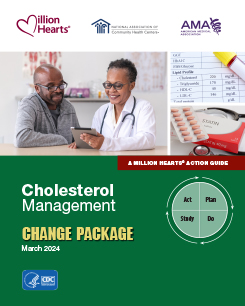Cholesterol Management Change Package
What Is the Cholesterol Management Change Package (CMCP)?
The CMCP was developed in partnership with the National Association of Community Health Centers (NACHC) and the American Medical Association (AMA). It presents a list of evidence-based process improvements that outpatient clinical settings can implement as they seek optimal cholesterol management. The CMCP is composed of change concepts, change ideas, and evidence- or practice-based tools and resources.
- Change concepts are general notions that are useful in the development of more specific ideas for changes that lead to improvement.
- Change ideas are specific, actionable ideas for changing a process. Change ideas can be rapidly tested on a small scale to determine whether they result in improvements in the local environment.
- Within each change idea, the CMCP lists evidence- or practice-based tools and resources that can be adapted or adopted in a health care setting to improve cholesterol management.
Although the science behind cardiovascular risk reduction is continually evolving, there is strong evidence that a systematic approach to cholesterol management can significantly improve cholesterol-related care processes and outcomes. The purpose of the CMCP is to help health care practices put more efficient and effective systems in place to care for patients with hyperlipidemia.
The CMCP is broken down into four focus areas:
How Should We Use the CMCP?
Start by assembling a team of physicians, pharmacists, nurses, medical assistants, and administrators to discuss the aspects of cholesterol management that are most in need of improvement. The team can then select corresponding interventions from the CMCP that best address those issues.
Each strategy you choose should first be tested on a small scale (i.e., with “small tests of change”) to assess feasibility and allow the team to evaluate and adjust before the change is instituted on a broader, more permanent scale.
We do not recommend that any practice attempt to implement all of the interventions at once, nor is it likely that all interventions will be applicable to your clinical setting.

